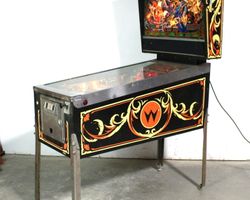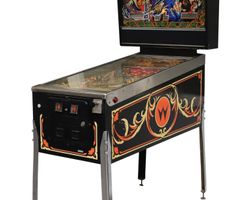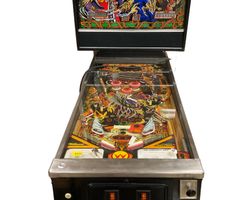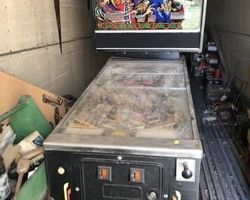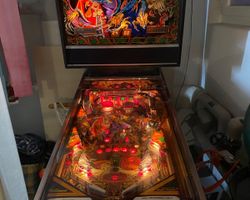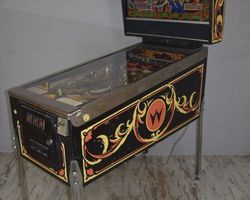Sorcerer
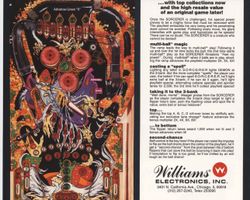
Average Prices: USD $200 to $2,100
Produced: March, 1985
Production Run: 3,700 units
Machine Type: Solid State Electronic
MPU: Williams System 9
Players: 4
Design by: Mark Ritchie
Art by: Pam Erickson
Williams Electronic Games, Inc. introduced Sorcerer to the pinball world in March 1985, a solid-state electronic machine that quickly carved out its identity. With a production run of 3,700 units, Sorcerer emerged from the Williams factory as a testament to the era's growing focus on immersive themes and engaging gameplay. The machine's concept drew heavily from a classic fantasy aesthetic, weaving together elements of magic, monstrous creatures, powerful wizards, and formidable dragons into its very fabric.
The creative forces behind Sorcerer included Mark Ritchie, who handled the design, crafting a playfield that balanced speed with strategic depth. Pam Erickson was responsible for the artwork, defining the machine's visual appeal with her detailed fantasy illustrations. On the software front, Dave Rzepka began the programming work, with Ed Suchocki completing the intricate code that brought Sorcerer to life. Suchocki later recounted an amusing exchange during development: Steve Kordek, then head of design, emphasized the importance of naming game features. Kordek’s insistence on giving new elements a distinct identifier, even jokingly suggesting "Yahootie!", led to the prominent "Demon" bonus lamp feature acquiring its memorable name. This internal anecdote illustrates the collaborative and iterative nature of pinball design, where even small details received careful consideration. An interesting production detail of Sorcerer lies in its playfield variations, with collectors noting two distinct color schemes for the sorcerer’s robe and the feathers on certain skull motifs, indicating potential changes during the manufacturing process or different screening vendors.
Signature Features and Design
Sorcerer stands out visually and mechanically through several defining elements. The back panel, adorned with a powerful wizard, features the Sorcerer's eyes which glow and flash, a captivating visual cue that enhances the mystical theme. This lighting effect contributes significantly to the machine’s theatrical presentation, particularly when the playfield action intensifies.
Mechanically, the game incorporated a standard two-ball multiball, a dynamic feature that injected immediate excitement and scoring potential into gameplay. Players were also introduced to custom speech samples, with the titular Sorcerer himself delivering taunts and encouragements that heightened the sense of engagement and immersion. Beyond these headline features, the machine included three flippers, providing varied shot angles and strategic depth. Two spinning targets added an element of speed and a satisfying tactile response when struck. A three-bank of drop targets presented a direct challenge, crucial for advancing game progression. Furthermore, a mini-post positioned between the flippers introduced an element of risk and reward, making center drains a constant threat and demanding precise control.
Playfield and Mechanics
The playfield of Sorcerer is a carefully orchestrated landscape of challenges and opportunities, laid out to guide players through a fast-paced fantasy adventure. A prominent feature is the single ramp located on the left side of the playfield, a primary shot that often leads into a kick-out hole, crucial for advancing toward multiball.
Central to the playfield's upper section is a three-bank of drop targets, often referred to as the "Orcere" targets due to their position and the partially obscured "SORCERER" spelling. Completing this bank is vital for lighting the "Demon" bonus lamp, and when "Demon" is lit, completing the bank again activates the bonus hold for the subsequent ball, a compelling strategic objective. The upper playfield also houses a third flipper, controlled by the left flipper button, strategically placed to interact with these drop targets and other upper-field elements, offering unique shot possibilities and a different dimension to play.
The playfield is populated with three pop bumpers, creating a chaotic, high-scoring zone typically at the top center. Six standup targets are scattered across the layout, providing distinct objectives for players to aim for and rewarding precision. Two slingshots guard the outlanes, adding to the defensive challenges and keeping the ball in active play. Pam Erickson's artwork infuses the playfield with a vibrant fantasy theme. Dragons, wizards, skulls, and mystical glyphs adorn every inch, utilizing a rich palette of blues, purples, reds, and greens. This detailed artistry is not merely decorative; it clearly delineates objectives and pathways, drawing the player deeper into Sorcerer's world. The interplay of artwork with the machine's lighting, particularly around the "Demon" bonus and the flashing Sorcerer's eyes on the backglass, creates an immersive aesthetic experience that complements the gameplay.
Gameplay Dynamics
Sorcerer's gameplay mechanics are designed for clear progression and accessible objectives, while still offering depth for experienced players. The primary goal often revolves around spelling "SORCERER" through various targets and shots on the playfield. Once completed, this achievement lights the "Demon" bonus lamp, a pivotal moment in the game. Subsequently, completing the three-bank drop targets when "Demon" is active triggers a bonus hold, which carries accumulated bonus points over to the next ball, a strategy that rewards consistent play and target accuracy.
The two-ball multiball is a major scoring opportunity and a key highlight of Sorcerer. It is typically initiated by hitting the left ramp multiple times to lock balls, leading to a dynamic, high-energy phase of play. During multiball, the game encourages players to hit specific shots to increase their score multipliers, transforming chaotic action into focused strategic aiming. The Sorcerer's custom speech further enhances these dynamics, with taunts and acknowledgements that provide immediate feedback on player performance and add character to the game. Scoring is straightforward, rewarding players for hitting targets, spinning the spinners, completing drop target banks, and achieving the multiball. The game’s design encourages a flow-oriented approach, where successful shots can often feed directly into subsequent opportunities, creating satisfying combos and sustained play. The challenge lies in maintaining control amidst the speed, navigating the mini-post between the flippers, and precisely timing shots to maximize bonus progression.
Reception and Legacy
Upon its release and in the years since, Sorcerer has garnered a predominantly positive reception within the pinball community, often being cited as an underrated classic from the Williams System 9 era. Many enthusiasts praise its captivating artwork, particularly Pam Erickson's vibrant backglass and detailed playfield, which are frequently cited as among the best of its time. The flashing Sorcerer's eyes in the back panel are a commonly appreciated visual flourish, enhancing the machine's theme.
The machine's gameplay receives commendation for its fast, smooth flow and satisfying shot geometry, providing a balance of challenge and approachability. The two-ball multiball is generally well-regarded, being both exciting and relatively easy to initiate, making it accessible for new players while still offering a pathway to high scores through multiplier progression. The custom speech and sound effects, especially the Sorcerer's taunts, are frequently highlighted as effectively fitting the theme and adding to the overall experience. Its straightforward rule set contributes to its high replayability, with many players finding themselves drawn back for "just one more game."
However, Sorcerer is not without its criticisms. Some players found the background music to be repetitive over extended play sessions, though this is often balanced by appreciation for the speech and specific sound effects. A common concern, particularly among collectors, is the propensity for playfield wear, largely attributed to the lack of factory mylar protection, which can lead to significant art degradation over time. A small minority of players felt the rule set lacked the deep complexity found in later machines, potentially leading to a quicker sense of mastering the game for seasoned players. There are also occasional notes on the "Orcere" target island being too close to the flippers for some, and the "multiball steal" mechanic, while adding chaos, isn't universally beloved.
Despite these minor points, Sorcerer holds a respected place in pinball history. It is recognized as a solid representation of Williams' design philosophy during the mid-1980s, offering a compelling blend of fantasy theme, engaging visuals, and a fun, accessible play experience. Its enduring appeal to both casual players and dedicated collectors solidifies its legacy as a memorable and sought-after pinball machine.
Sponsored Links
 Ebay Listings
Ebay Listings
 Auction Results
Auction Results
| Cost | Location | Date |
|---|---|---|
| USD $850 |  Pennsylvania, United States Pennsylvania, United States |
23 January, 2025 |
| USD $3,000 |  Pennsylvania, United States Pennsylvania, United States |
07 December, 2024 |
| USD $2,800 |  New York, United States New York, United States |
10 June, 2024 |
| USD $2,200 |  California, United States California, United States |
10 June, 2024 |
| USD $1,000 |  California, United States California, United States |
17 November, 2023 |
| USD $2,700 |  California, United States California, United States |
08 May, 2023 |
| EUR €1,330 |  Hessen, Germany Hessen, Germany |
29 March, 2023 |
| USD $1,100 |  Maryland, United States Maryland, United States |
23 February, 2023 |
| EUR €1,610 |  Nordrhein-Westfalen, Germany Nordrhein-Westfalen, Germany |
18 December, 2022 |
| USD $2,500 |  Ohio, United States Ohio, United States |
28 October, 2022 |


Private Policy · Search Website · Contact Us
As an eBay Partner, we may earn a commission from qualifying purchases made through links on this site, at no additional cost to you.
All trademarks and copyrighted materials remain property of their respective owners. All other content copyright 2007 - 2025 Pinpedia.

